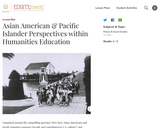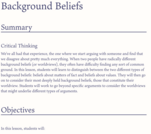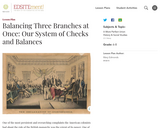
Use this Lesson following The Ratification Debate on the Constitution Narrative.
- Subject:
- Social Science
- Social Studies
- Material Type:
- Lesson Plan
- Provider:
- Bill of Rights Institute
- Date Added:
- 09/12/2022

Use this Lesson following The Ratification Debate on the Constitution Narrative.

Use this lesson after reading The Constitutional Convention Narrative and/or the Constitutional Convention Lesson.

Arizona v. Hicks (1987) clarified the need for probable cause when seizing evidence in plain view. The United States Supreme Court found that officers must reasonably suspect criminal activity in order for them to lawfully seize items in plain view without a search warrant.

Students learn about the Fourth Amendment’s requirements for arrests and searches. Then in a paired writing activity, they take the role of television writers and create scenarios illustrating legal arrests and searches. Access to this resource requires a free educator login.

This resource from the National Constitution Center includes an introduction, big questions, recorded class sessions, briefing documents, slide decks, and worksheets about Article I of the United States Constitutuion.

This resource from the National Constitution Center includes an introduction, big questions, recorded class sessions, briefing documents, slide decks, and worksheets about Article II of the United States Constitutuion.

This resource from the National Constitution Center includes an introduction, big questions, recorded class sessions, briefing documents, slide decks, and worksheets about Article III of the United States Constitutuion.

The purpose of this lesson is to assist student understanding of the U.S. Supreme Court created under the Constitution. Through a document exploration and story-telling activity, students will understand the role of the Supreme Court in our constitutional system of government. Students will also explore how the Court’s role has evolved over time by looking to a number of key Supreme Court decisions.

This is part one of our short animated series that covers the Constitution of the United States. This video teaches kids (and adults) in simple terms about the first part of article one of the constitution.

This resource from the National Constitution Center includes an introduction, big questions, recorded class sessions, briefing documents, slide decks, and worksheets about Article V of the United States Constitutuion.

This resource from the National Constitution Center includes an introduction, big questions, recorded class sessions, briefing documents, slide decks, and worksheets about Article VII of the United States Constitutuion.

In 1777, the Second Continental Congress adopted the Articles of Confederation. The objectives of this activity are: Students will analyze the provisions of the Articles of Confederation. Students will determine why individuals such as George Washington expressed a growing concern over government’s inadequacies, and why these concerns were expressed by and heightened after events such as Shays’s Rebellion. Students will explain why there was a growing call for creating a strong central government and the rationales for the various arguments.

Articles of Confederation- A brief description of the AofC and some short videos.

Organized around the compelling question "How have Asian Americans and Pacific Islanders engaged civically and contributed to U.S. culture?" and grounded in inquiry-based teaching and learning, this lesson brings history, civics, and the arts together to learn about the experiences and perspectives of Asian Americans and Pacific Islanders (AAPI) in U.S. history. elementary sources, literature, and works of art created by AAPI individuals and related organizations provide an historical as well as contemporary context for concepts and issues including civic participation, immigration, and culture.

We've all had that experience, the one where we start arguing with someone and find that we disagree about pretty much everything. When two people have radically different background beliefs (or worldviews), they often have difficulty finding any sort of common ground. In this lesson, students will learn to distinguish between the two different types of background beliefs: beliefs about matters of fact and beliefs about values. They will then go on to consider their most deeply held background beliefs, those that constitute their worldview. Students will work to go beyond specific arguments to consider the worldviews that might underlie different types of arguments.

Baker v. Carr (1962) was a landmark case concerning re-apportionment and redistricting. The United States Supreme Court ruled that federal courts could hear and rule on cases in which plaintiffs allege that re-apportionment plans violate the Equal Protection Clause of the Fourteenth Amendment.

Learn about the checks and balances system of the three branches of the U.S. government.

In this lesson, students learn about President Obama’s life, family, and political career as they interact with a slide presentation. Access to this resource requires a free educator login.

In this lesson students will discuss what the necessary and proper clause means to them. They will also put themselves into the shoes of citizens in 1791 and look at Alexander Hamilton’s and Thomas Jefferson’s opinions on the national bank. Students will also learn about the war debt and currency issues so as to better understand the national bank debate. This lesson may be used in an American history class or civics classes as it will allow students to analyze and use primary sources as part of a continuation in developing their social studies skills.

In this webinar by iCivics and the Center for Civic Education, Henry L. Chambers, Jr., Emma Humphries, and Mike Fassold explain the long and troubled history of voting rights in the United States and share tips for teaching representation and the expansion of suffrage.
Mike Fassold, an educator from Fishers Junior High School in Indiana, explains how he teaches the expansion of voting rights using the We the People middle school curriculum. Fassold is followed by Professor Henry Chambers, the Austin E. Owen Research Scholar & Professor of Law at the University of Richmond, who discusses the 2020 Census, apportionment, and gerrymandering. Finally, Emma Humphries, the Chief Education Officer at iCivics, explores compelling new infographics and Web activities on the census, gerrymandering, and voting that will engage your students.